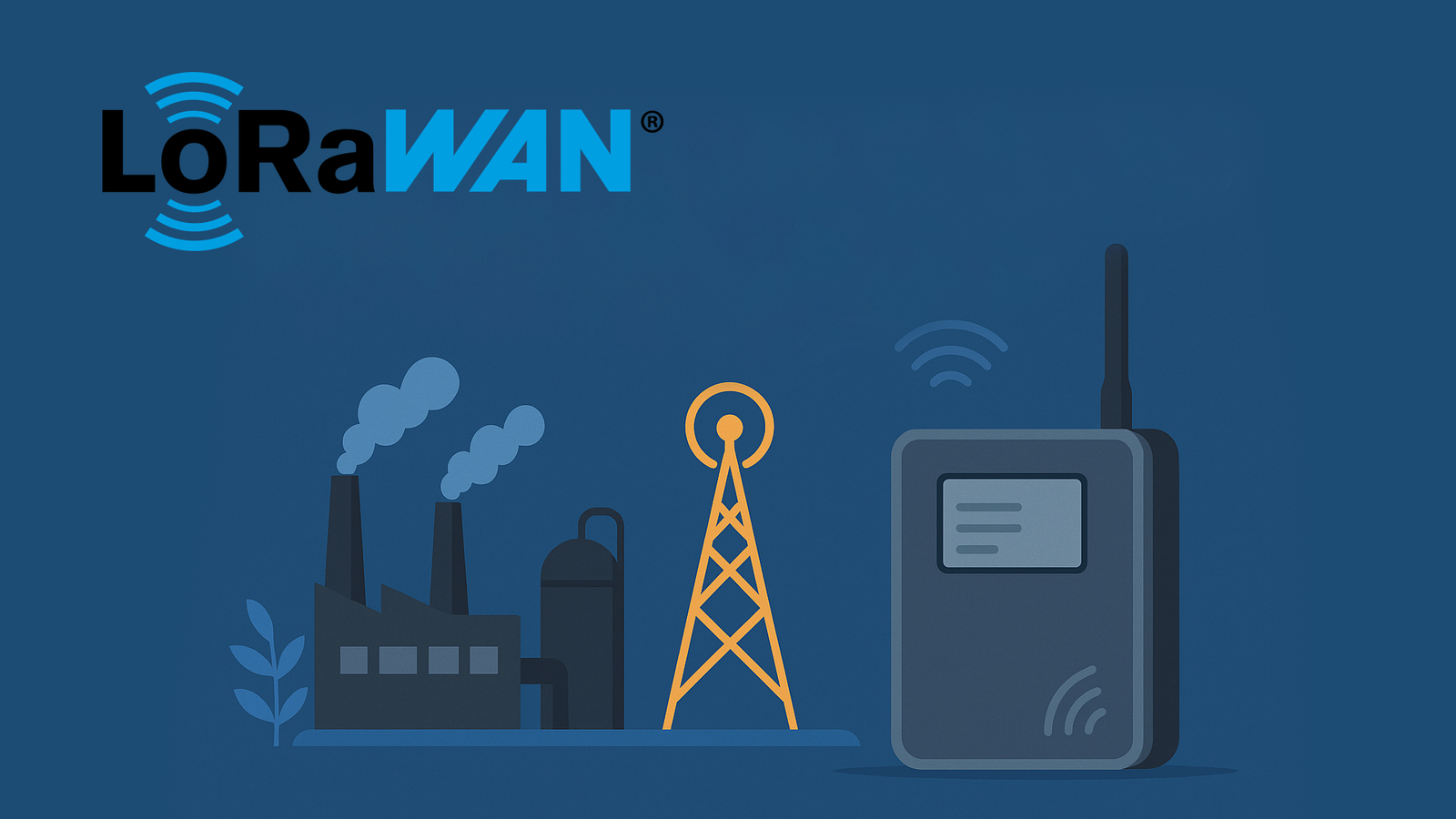
Industrial facilities face connectivity challenges that traditional wireless technologies cannot solve. WiFi reaches only 100 meters, cellular requires expensive data plans, and Bluetooth covers mere 10 meters. LoRaWAN addresses these limitations with 15-20km range in rural areas and 2-5km in urban environments, while consuming just 10-50mA during transmission and 1-5µA in sleep mode.
Industrial IoT deployments demand reliable, long-range communication that operates in harsh electromagnetic environments. LoRaWAN device design provides the foundation for connecting sensors, controllers, and monitoring systems across vast industrial complexes without infrastructure investment. This guide covers the essential principles for developing robust LoRaWAN solutions that meet industrial requirements.
LoRaWAN vs. Other Wireless Technologies: Why Choose LoRaWAN Device Design?
LoRaWAN outperforms competing technologies in industrial scenarios through superior range, power efficiency, and penetration capabilities. Understanding these advantages guides technology selection decisions.
Range comparison reveals LoRaWAN’s dominance: WiFi achieves 100m maximum, Zigbee reaches 300m with mesh networking, while LoRaWAN delivers 15km+ line-of-sight with single gateway coverage. This eliminates complex mesh infrastructure and reduces deployment costs by 60-80%.
Power consumption analysis shows LoRaWAN’s efficiency. Cellular IoT modules consume 100-200mA during transmission, limiting battery life to months. LoRaWAN devices transmit using 20-50mA for 1-2 seconds, enabling 5-10 year battery operation with proper sleep mode implementation.
Penetration performance matters in industrial environments with concrete walls and metal structures. LoRaWAN’s sub-GHz frequency (868MHz EU, 915MHz US) penetrates obstacles better than 2.4GHz technologies, maintaining connectivity where WiFi and Bluetooth fail.
LoRaWAN Hardware Design Fundamentals for Industrial Applications
Successful LoRaWAN device design balances performance, cost, and regulatory compliance. Proper impedance matching and filtering ensure maximum power transfer and spurious emission control.
Transceiver selection determines baseline performance. SX1276/SX1278 chips provide +20dBm maximum output power with -148dBm receive sensitivity, enabling maximum range potential. Newer SX1262/SX1268 variants offer improved efficiency and integrated DC-DC converters.
Crystal oscillator accuracy affects frequency stability and regulatory compliance. ±10ppm crystals ensure proper operation across temperature ranges while meeting regional spectrum requirements. Temperature compensated crystal oscillators (TCXO) improve stability in harsh industrial environments.
Antenna Design for Maximum Range
Antenna selection and placement critically impact transmission range and reliability. Proper antenna design can improve range by 6-10dB compared to poor implementations.
Quarter-wave monopole antennas provide omnidirectional coverage with 2.15dBi gain at 868MHz. PCB trace antennas save cost but deliver 2-3dB less performance than discrete antennas, reducing range by 25-40%.
Ground plane requirements ensure optimal antenna performance. Minimum 5x5cm ground plane supports quarter-wave antenna efficiency. Larger ground planes (10x10cm) improve performance by 1-2dB.
Antenna placement away from metal objects and high-current traces prevents detuning and interference. Minimum 1cm clearance from metal components maintains radiation pattern integrity.
RF Circuit Considerations
RF circuit design balances performance, cost, and regulatory compliance. Proper impedance matching and filtering ensure maximum power transfer and spurious emission control.
Impedance matching networks transform antenna impedance to 50Ω system impedance. Pi-network configurations using discrete components provide flexibility for different antenna types. VSWR below 1.5:1 across the operating band ensures efficient power transfer.
Harmonic filtering prevents spurious emissions that violate regulatory limits. Low-pass filters with 40dB+ attenuation at second harmonic frequencies ensure CE and FCC compliance. Integrated filters in transceiver modules simplify design but limit customization.
LoRaWAN Gateway Development and Device Design Process
Gateway development enables network infrastructure for LoRaWAN device connectivity. Understanding gateway requirements guides system architecture decisions.
Packet forwarder software manages LoRa radio hardware and connects to network servers via IP networks. Open-source solutions like packet_forwarder provide proven baseline functionality with customization capabilities.
Concentrator modules (SX1301/SX1308) enable simultaneous reception on multiple channels and spreading factors. These modules handle up to 10,000 devices per gateway with proper network server configuration.
Backhaul connectivity options include Ethernet, WiFi, and cellular connections. Redundant connectivity ensures network reliability in critical industrial applications.
Industrial LoRaWAN Device Applications and Success Stories
LoRaWAN deployments demonstrate proven value across industrial applications. Understanding successful implementations guides project planning and ROI calculations.
Asset tracking applications achieve 90% reduction in manual inventory costs. Battery-powered trackers provide location updates every 15-30 minutes with 3-5 year operational life, eliminating labor-intensive tracking processes.
Environmental monitoring systems cover 50-100 square kilometers with single gateway installations. Temperature, humidity, and air quality sensors transmit hourly readings, enabling predictive maintenance and regulatory compliance documentation.
Utility metering deployments reduce reading costs by 75% while improving accuracy. Smart meters transmit daily consumption data with 10+ year battery life, eliminating manual meter reading requirements.
CE Certification Requirements for LoRaWAN Device Design
European market access requires CE certification demonstrating compliance with essential requirements. Understanding certification processes prevents costly delays and redesign requirements.
RED (Radio Equipment Directive) 2014/53/EU governs LoRaWAN device certification. Testing covers radio spectrum efficiency, electromagnetic compatibility (EMC), and electrical safety requirements.
Harmonized standards EN 300 220 and EN 301 489 provide compliance pathways. Testing includes conducted and radiated emissions, immunity testing, and spurious emission measurements.
Notified body involvement depends on device classification. Most LoRaWAN devices qualify for simplified procedures with manufacturer declarations, reducing certification time and costs.
NORVI’s LoRaWAN Device Design and Development Methodology
NORVI’s systematic approach to LoRaWAN development ensures regulatory compliance and optimal performance. Our methodology integrates hardware design, testing, and certification processes.
Requirements analysis defines range, battery life, and environmental specifications based on application needs. Power budgets and link budgets establish feasibility boundaries before hardware design begins.
Prototype validation includes RF performance testing, range verification, and regulatory pre-compliance testing. Anechoic chamber measurements confirm antenna patterns and emission compliance.
Production support covers component sourcing, manufacturing testing, and ongoing compliance maintenance. Our relationships with test laboratories expedite certification processes and reduce time-to-market.
Conclusion
LoRaWAN device design enables industrial IoT applications impossible with traditional wireless technologies. Success requires understanding RF principles, regulatory requirements, and proven development methodologies.
NORVI’s expertise in LoRa product development, from hardware design through CE certification, helps clients achieve industrial IoT objectives with reliable, compliant solutions. Our comprehensive approach ensures projects meet performance targets while minimizing development risks.
Ready to develop your LoRaWAN industrial IoT solution? Contact NORVI’s engineering team to discuss your connectivity requirements and explore how LoRaWAN technology can transform your industrial operations.